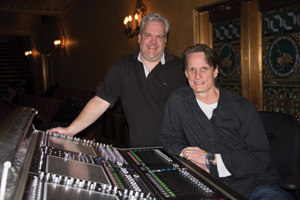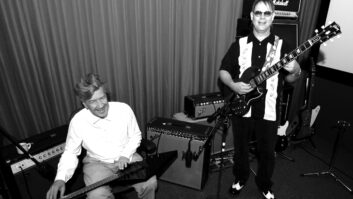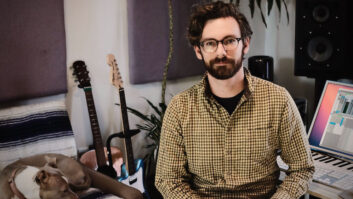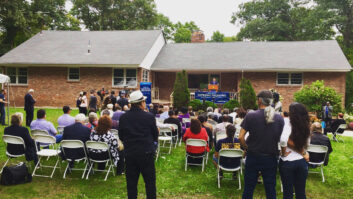
David Patridge and John Shivers at the DiGiCo SD7T
Photo: Lisa Kovarik
For more about the audio for Kinky Boots’ Broadway production, sound designer John Shivers and front-of-house engineer David Patridge offer their further thoughts:
How would you describe your collaboration for Kinky Boots and working history?
Shivers: David and I have known each other for years having first worked together on the Buddy Holly Story at the Schubert Theater [in New York City] in 1990. It was obvious then that we would work together again as we had very similar work ethic and aesthetic. After going our separate ways for many years—David working on the world wide productions of Mamma Mia and me on the numerous Lion King productions—we reunited on a crazy show called In My Life> in 2005. We have pretty much worked together on everything since then. He is the yin to my yang and I am the yang to his yin…
Does the live mix differ each night?
Shivers: The idea is to generate as consistent a mix from show to show as possible. The challenge is make this happen with constantly changing input. It is live, after all, and as good as the cast and musicians are, there are variances in every performance. There are also the effects temperature and humidity have on the overall sound. So you are really constantly dialing in a new mix to one degree or another.
Patridge: Of course it does. That is the plus and minus of live sound. The humans involved at both ends of the performance, actor/musician and mixer,—coupled with the humidity and temperature—make it very fluid.
What did you know about the Al Hirschfeld Theatre before Kinky Boots moved in there?
Shivers: Never having done a show in the venue, not much. We did a couple of site surveys to get a feel for the space and to get particulars for the system design.
Why did you choose the DiGiCo SD7T for Kinky Boots at FOH?
Shivers: The SD7T offers a great deal of flexibility, reliability and solid sonic quality. It is sort of the go-to Broadway console these days.
[Read more about Shivers’ choice of the DiGiCo SD7T for Kinky Boots].
Which console effects or features are most used?
Patridge: The SD7T offers a very unique feature called Theatre Software. This feature really sets the SD7 apart and allows us to combine the recall-ability an automation of a digital console with the manual feel of a traditional console. The console has dynamic compression and dynamic EQ, which are very useful. The gates are musical and fairly equivalent to outboard hardware and the internal reverbs and delays can be incorporated from moment to moment using the console automation in ways that could never be achieved using traditional outboard processing.
What does the TC Electronic 6000 reverb contribute?
Patridge: The latest TC reverb algorithms are very transparent and natural sounding. It is easy to get a great vocal reverb and to play with it to get several more great choices. The TC Icon software allows us to access the TC over our network which is very useful and storing presets or loading them from other saved shows is really simple. We don’t use it on Kinky Boots but we have also taken advantage of 5.1 surround presets that the 6000 offers. And the audio interfacing is all AES, which simplifies patching to the console using the local AES inputs and outputs.
How is the orchestra miked?
Patridge: We tend to stick to a range of mics that we know well and luckily the Broadway audio vendors, like Masque Sound, stock some really excellent choices. I can recall working in venues where the whole drum kit had to be done with Shure SM57 mics years ago, and we’re spoiled having ample supplies of large diaphragm Neumann mics and an array of dynamic mics and condensers from multiple manufacturers. It is important to choose the right tool for the job because if you start putting the sound together with a bad input you are crippling yourself. It is great that, with microphones, we share a lot of common ground with live music, recording and broadcasting so manufacturers have really stepped it up and produced a lot of great mics over the past 20 years, which make the job easier.
Why did you select a Yamaha PM5D console for monitors?
Patridge: The PM5D is a reliable workhorse and we chose it for its channel count and the ability to install MY cards to connect MADI directly from the DiGiCo SD Racks, which eliminated any additional splitters. Monitor consoles on most musicals are essentially provided to expand the routing capability of the FOH console and to allow independent control of EQ and processing on the channels that are mixed into stems to feed the Aviom system in the pit. If a show is small enough, the SD7 has an excellent ability to provide additional channels of processing and a feature called Gain Tracking within the desk to enable mixing monitor stems from FOH. On Kinky Boots, we didn’t have enough inputs left at FOH so the PM5D was added. It is a very cost-effective solution at a time when most people want something shinier and newer when they select gear!
The PM5D sits there unattended. We keep it covered so that it doesn’t get too dusty and brush it off once in a while! The band is able to control their own mix via the Aviom system so once the monitor mix is established, it is “set and forget.”







